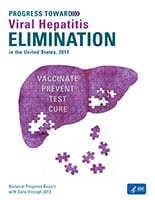National Viral Hepatitis Progress Report
The Centers for Disease Control and Prevention (CDC) strives to prevent viral hepatitis infections and eliminate disease and mortality caused by viral hepatitis. The National Viral Hepatitis Progress Report provides information on progress in the implementation of recommended interventions and the impact these interventions are having on prevention of viral hepatitis transmission, disease, and associated mortality.
Report At-A-Glance
Seven indicators provide an objective way to assess progress toward achieving key viral hepatitis goals. Select the indicator from the table below for more information.
The seven indicators and accompanying 2020 goals compiled specifically for the National Progress Report were adapted from other initiatives, including Healthy People 2020, HHS’s National Viral Hepatitis Action Plan, 2017-2020[PDF – 84 pages], and CDC’s Viral Hepatitis Strategic Plan, 2016-2020[PDF – 17 pages].
- Hepatitis A vaccination coverage has increased, but not enough to meet the annual target. The large increase in the hepatitis A incidence rate for 2016 highlights the importance of vaccination as well as public health surveillance to identify and respond to outbreaks of hepatitis A.
- The incidence of acute hepatitis B among adults increased from 2014 through 2015, and then decreased slightly from 2015 through 2016, but not enough to meet the annual goal. Furthermore, newborn hepatitis B vaccination coverage declined in 2016, when almost 30% of newborns did not receive hepatitis B vaccination within 3 days of birth, leaving these young children unnecessarily vulnerable to hepatitis B virus infection.
- Of great concern are the ongoing and apparent large increases in the incidence of reported acute hepatitis C. The lack of a hepatitis C vaccine and increases in injection-drug use related to the nation’s opioid crisis have contributed to these increases in acute hepatitis C. Efforts to curb hepatitis C virus (HCV) transmission and identify all new (acute) and existing (chronic) infections must continue, especially since well-tolerated, short-course treatments are available that can cure almost all HCV-infected persons.
- The nation has made progress towards reducing deaths related to hepatitis B and hepatitis C, and the 2016 annual targets were met for both mortality indicators.
Fact Sheet
Previous Reports

Progress Toward Viral Hepatitis Elimination in the United States[PDF – 46 pages] was the inaugural report published in 2017 that included data through 2015. The comprehensive report highlighted the nation’s progress at the time toward reducing the burden of hepatitis A, hepatitis B, and hepatitis C.






















.png)











No hay comentarios:
Publicar un comentario